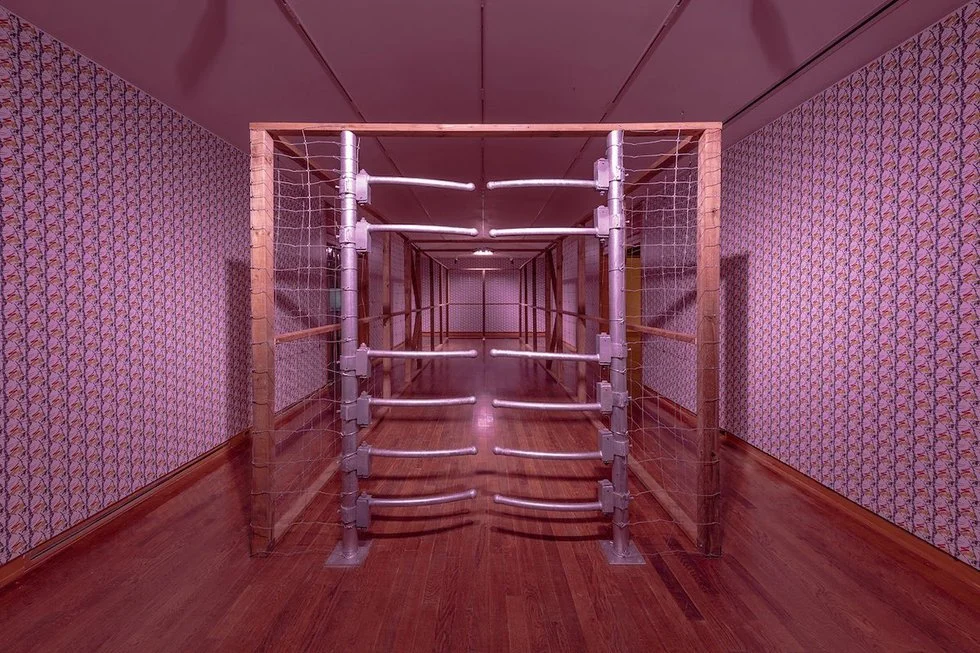Ursula Johnson interview with NOW Magazine
Sobey Art Award winner Ursula Johnson spreads her wings
The Mi’kmaw artist talks about her big prize win, moose fencing and how she became a butterfly
Ursula Johnson’s installation Moose Fence (photo Toni Hafkenscheid)
Mi’kmaw artist Ursula Johnson has won this year’s $50,000 Sobey Art Award. It’s a well-deserved win in a strong year for the national art prize, which focuses on artists under 40.
It marked the first time a nominee from the Atlantic region has prevailed. At the ceremony last week, Johnson first addressed the crowd in Mi’kmaq before switching to English because “nobody can understand me but my Mom,” she said.
The speech reflected her artistic approach: opening up traditional practices so they have contemporary relevance.
A member of Cape Breton’s Eskasoni First Nation, the 37-year-old’s art encompasses installation and performance, often incorporating skills learned from her elders, like basket weaving.
Johnson’s installation at the Sobey Art Award exhibition at U of T’s Art Museum is Moose Fence, based on fencing used to prevent animals from straying into traffic. NOW spoke with Johnson about the piece and her wider practice.
Congratulations on the win! How does it feel?
Thank you! I am kind of vibrating with excitement. I can’t believe it.
For any artist who wins this type of prize it must be a shock. It’s so separate from what you do to win this kind of prize.
Yes. It seems more like what an athlete does – training for competition. Artists are creating things with materials or mediums to try to communicate what’s in our minds. There is no [finish] line.
I really love Moose Fence. Could you talk about it?
I’ve wanted to make Moose Fence for years now, but I needed the right space, one with an intersecting gallery to disrupt movement of people so the work could convey the idea I was interested in. This type of fence is very familiar for people in Eastern Canada. It has an ominous feel because it represents a dangerous situation for animals – specifically ungulates or animals with hoofed feet. I wanted to create that feeling for humans. I want visitors to think about these barriers we create between us and nature.
Visitors can choose to go inside the cage or not – nobody wants to be inside a cage, and neither do moose. So it points out that we have this power over animals.
Absolutely. I wanted to create a situation where people couldn’t tell at first – if they entered the cage – that there was a way out. If they are not familiar with this type of undulate gate, they don’t know it’s a one-way gate. There’s a moment of panic maybe before they realize there are also doors on the side. This introduces something that features a lot in my practice. You might ask someone to help – you collaborate.
This project also connects to your basket weaving performances. There’s one where you weave a basket so by the end you are enclosed by it. This implies you are only a part of the tradition you are working within.
My family are basket weavers. Once I started to explore this, it led me down a whole different path, being able to spend time with the elders in my community and my great grandmother and following them around with video cameras. I learned some important life lessons by asking them things like, “How does this relate to conservation practices and sustainability?”
The first time I did [the basket weaving performance] I was in art school, and I had the punk rock hair and piercings in my face. I thought, “I’m going to do something really on the edge,” and I went to ask my great grandmother if it would be okay. She laughed hysterically and said, “That’s going to be a really big basket!”
It was at an Indigenous art festival in Halifax at Dalhousie [University]. I worked for three days and struggled with it horribly. At one point, I looked up at people on a balcony who were looking down on me – these Maliseet First Nations women who were basically laughing at me. I felt so humbled and went up to them and said, “I have no idea what I’m doing. I really need some help.” They helped me and that was an important lesson. So many people engaged in this beautiful process and that propelled the entire way that I work now.
How did you get out of the basket in the end?
I fell onto the floor and lay there for a bit. Then I crawled out the bottom. I thought, “Oh, I’ve emerged from my cultural cocoon. I’m no longer a larva – I’m a butterfly now.”
The Sobey Art Award exhibition runs to December 9 at the Art Museum at the University of Toronto (7 Hart House Circle).
